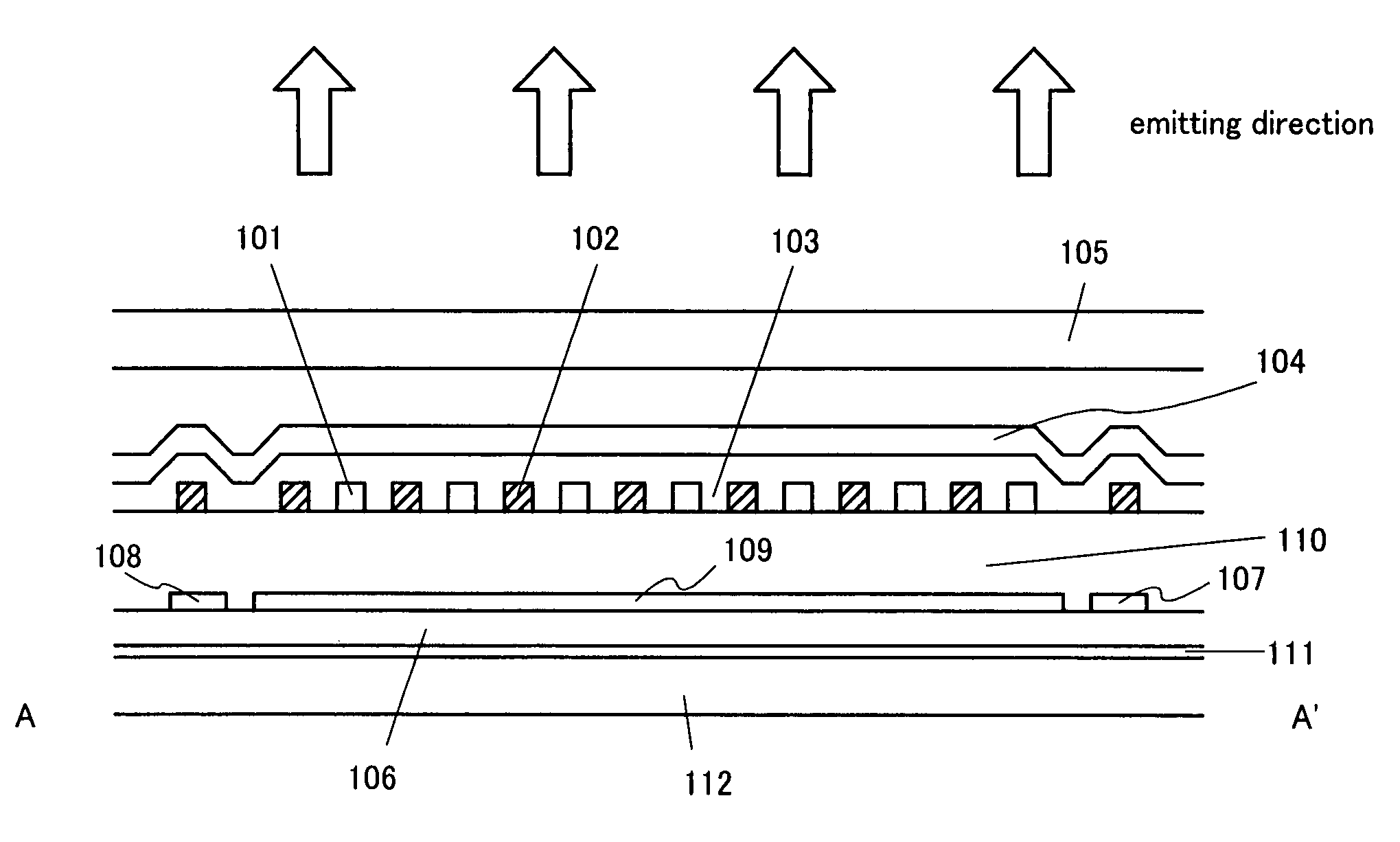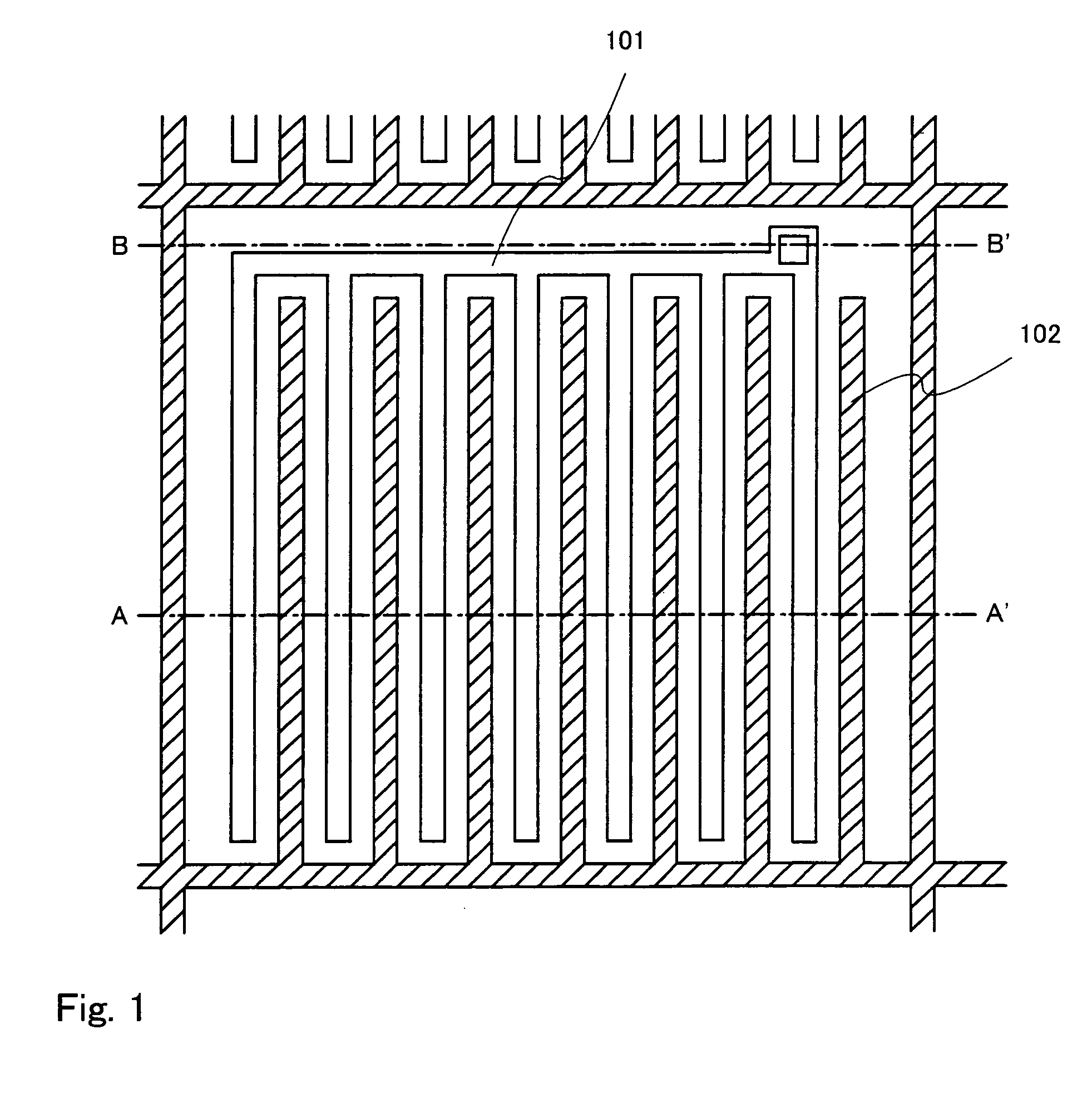Light emitting device having both electrodes formed on the insulating layer
a technology of insulating layer and light emitting device, which is applied in the direction of discharge tube/lamp details, organic semiconductor devices, discharge tube luminescnet screens, etc., can solve the problems of small work function of cathode and general intransparency of its substan
- Summary
- Abstract
- Description
- Claims
- Application Information
AI Technical Summary
Benefits of technology
Problems solved by technology
Method used
Image
Examples
embodiment 1
[Embodiment 1]
[0029]A light emitting device of the present invention will be described using FIGS. 1 and 2. FIG. 1 is a top view of one pixel provided in the light emitting device. Here, a cross sectional view corresponding to a cross section cut along a line A–A′ in FIG. 1 is shown in FIG. 2 and a cross sectional view corresponding to a cross section cut along a line B–B′ in FIG. 1 is shown in FIG. 9. Note that the same reference symbols are used for the same portions in FIGS. 1, 2, and 9.
[0030]In this embodiment, an active light emitting device will be described.
[0031]In FIG. 2, reference numeral 112 denotes a substrate and reference numeral 111 denotes an insulating film as a base. As the substrate, a silicon substrate, a glass substrate, a quartz substrate, or a plastic substrate is used. When the silicon substrate is used, minute patterning can be performed by using an existing LSI line. Thus, it is preferable to use the silicon substrate. Two or more transistors are provided i...
embodiment 2
[Embodiment 2]
[0047]A light emitting device of the present invention having a structure in which a bipolar layer and a layer containing a luminescent material are laminated as a light emitting layer will be described using FIG. 13. After the cathode and the anode are formed, the bipolar layer is formed. The bipolar a layer is formed by a method described in Embodiment 1. It is required that the film thickness of the bipolar layer is sufficiently smaller than the height of the electrodes. The layer containing the luminescent material is formed on the bipolar layer. As the layer containing the luminescent material, a layer made of one kind of luminescent material or a layer in which the luminescent material is mixed with a mixture made of plural kinds of materials may be used. Thus, when it is viewed along a line C–C′ in FIG. 13, the light emitting element constructed by the anode, the bipolar layer, the layer containing the luminescent material, the bipolar layer, and the cathode can...
embodiment 3
[Embodiment 3]
[0048]A light emitting device in which light is emitted from the lower side of the substrate will be described using FIG. 5. As a substrate 112, a transparent glass substrate, a quartz substrate, or a plastic substrate is used. A reflective film 109 is formed in an upper portion of a light emitting layer 103. The reflective film 109 may be formed over a passivation film 104 or under the passivation film 104. When the reflective film 109 is formed over the passivation film 104, a transparent material is used for the passivation film 104. In this structure, since, of lights produced in the light emitting layer 103, light emitted to the upper side of the substrate is reflected by the reflective film 109, light can be emitted from the lower side of the substrate. Thus, the external quantum efficiency is increased. Another portions are made to be the same structure as Embodiment 1.
PUM
 Login to View More
Login to View More Abstract
Description
Claims
Application Information
 Login to View More
Login to View More - R&D
- Intellectual Property
- Life Sciences
- Materials
- Tech Scout
- Unparalleled Data Quality
- Higher Quality Content
- 60% Fewer Hallucinations
Browse by: Latest US Patents, China's latest patents, Technical Efficacy Thesaurus, Application Domain, Technology Topic, Popular Technical Reports.
© 2025 PatSnap. All rights reserved.Legal|Privacy policy|Modern Slavery Act Transparency Statement|Sitemap|About US| Contact US: help@patsnap.com



